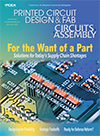Features Articles
 The road to resilience for Western manufacturing must begin with small steps.
The road to resilience for Western manufacturing must begin with small steps.
For more than three decades, leading electronics brands in the West have enshrined leanness, maximum efficiency and lowest cost. The drive to outsource manufacturing to areas where labor costs are lowest has enabled the industry to deliver more advanced electronic products at relatively affordable prices.
It has made perfect sense for the world's OEMs, relieving demand for capital investment and helping to cut costs while giving access to cutting-edge processes and providing rapid, low-risk scalability. The trend to outsource began in the late 1970s and became the dominant model in the '80s and '90s. Throughout the 21st century, this has been the way to operate a competitive supply chain. Now, the largest EMS operations are based in China and Southeast Asia and the sector is currently worth about $800 billion. It's still growing at more than 7% compounded annually.
But something else happened during this transformation. As production migrated geographically, the essential skills associated with designing and making advanced electronics products also moved away from the OEMs and became concentrated in Asia. Many associated industries also moved out. In the 1980s there were 23 full-scale manufacturers of substrate base materials in Europe. Currently, there are two. Similarly, the number of manufacturers of glass and copper foil has fallen from 12 to just one.
 Seemingly small issues can have big print implications.
Seemingly small issues can have big print implications.
Most reading this column are probably familiar with "The Princess and the Pea" fairy tale by Hans Christian Andersen, wherein a tiny pea under 20 mattresses keeps a true princess from a good night's sleep. Similarly, in the stencil printing process, seemingly small settings or interferences can prevent a good print outcome – particularly as assemblies continue to move toward higher densities and miniaturization. Our team had such a scenario recently while troubleshooting the cause for incomplete deposits on a complex board assembly.
This project involved printing on ultra-thin substrates – approximately 400µm thick. That's about the thickness of a playing card, so very, very thin, which makes for challenging print stability. Moreover, the panel was on the larger side, about 400mm x 400mm made up of multiple PCBs with no routing, making it more difficult to ensure coplanarity during printing. Tooling stability is always critical and even more challenging with very thin substrates. Today's tooling support solutions number a handful of options: Equipment standard tooling pins, reconfigurable pin systems like Grid-Lok, smart automatic pin placement, and dedicated tooling blocks with and without vacuum. Given the size and thickness of this substrate, our team used dedicated tooling blocks with vacuum to offer the most robust support for the process analysis.
Proper fab specs can prevent a deluge of engineering questions.
 I have been selling bare printed circuit boards for over 30 years to a variety of customers who order a wide selection of PCBs. The most common complaint I hear from board buyers is about the number of engineering questions (EQs) asked whenever a new order is placed, or when a part number is moved from one supplier to another.
I have been selling bare printed circuit boards for over 30 years to a variety of customers who order a wide selection of PCBs. The most common complaint I hear from board buyers is about the number of engineering questions (EQs) asked whenever a new order is placed, or when a part number is moved from one supplier to another.
"Why can't you build the boards without all these questions?" they ask. "We sent you the working files!"
To many buyers, the inevitable EQs that come along with moving a PCB order to a more cost-effective supplier seem daunting. Sure, the new pricing may be great, but many PCB buyers will delay switching to a new supplier because they don't want to deal with engineering questions from the new fabricator.
Our newest column shares tips and tricks and lessons learned over 30 years in PCB design.
 With today's complex printed circuit board (PCB) designs challenging us at almost every stage of the design process, along with shortened project schedules and shrinking budgets, achieving success is no easy feat. Smaller component packages, faster signal edge rates or rise times, and increased design for manufacturing (DfM) challenges all make it difficult to achieve success and get product to market on time and under budget. The foundation for achieving success is understanding PCB design (the full design process) and mastering the power of today's EDA tools.
With today's complex printed circuit board (PCB) designs challenging us at almost every stage of the design process, along with shortened project schedules and shrinking budgets, achieving success is no easy feat. Smaller component packages, faster signal edge rates or rise times, and increased design for manufacturing (DfM) challenges all make it difficult to achieve success and get product to market on time and under budget. The foundation for achieving success is understanding PCB design (the full design process) and mastering the power of today's EDA tools.
Even so, design teams can lose valuable time on unproductive tasks. Designers need a collaborative approach to electronic systems design that keeps them connected through all engineering disciplines and gives them best-in-class solutions to handle complexity across the entire PCB design process.

Remember to sell the excitement of the industry.
As finding and hiring talent has become so difficult over the past several years, it seems in every conversation I have, especially when younger people are involved, the subject turns to the need for talent in the world of manufacturing. With the baby boomers retiring in record numbers and the millennial generation showing so little knowledge of, or interest in, manufacturing, while appearing to prefer a "gig" type of employment (read: it's just a temporary job), my mantra of talking about the needs of industry for new talent at times seems like a broken record.
 Is the next generation of designers honing its skills on Minecraft?
Is the next generation of designers honing its skills on Minecraft?
If there were a record for the longest wait for a technology to take off (longest gestation period for a new technology), then virtual reality must surely be a top candidate for the honor. As long ago as 1990, the movie Total Recall gave mainstream audiences a dystopian view of the way life could be. The intervening three decades have cemented the image of the headset-wearing gamer in our minds – totally immersed in the experience yet oblivious to all around. And still it has failed to gain a large-scale following. Until now, perhaps.
With equipment sales currently rising at about 14% per annum according to research by IDC, all the big consumer technology brands are planning major new product launches in the coming months. Growth should accelerate to more than 30% in the next five years.
Press Releases
- Critical Manufacturing Partners with Canonical to Expand Cloud-Native Deployment Options for Manufacturers
- Heller Industries Becomes the Latest Partner to Join THE SMT FUTURE EXPERIENCE
- AIM Solder Signs New Distributor in Vietnam
- Variosystems launches AI platform for secure and connected supply chain services


